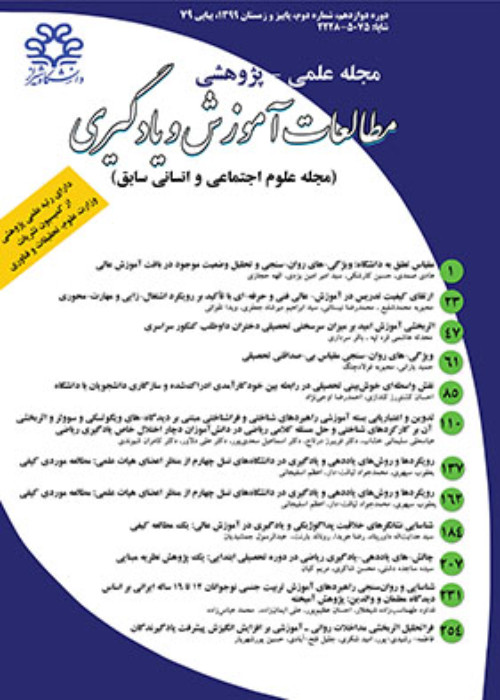Academic Motivation and Emotions Based on Academic Engagement Profiles for High School Students
Student engagement in educational activities is one of the most important issues in explaining the rate of academic dropouts as well as the number of students remaining at schools or entringhigher levels of education and work (Christensen, Rashly & Wyle, 2012). Students who are more engaged in school earn higher grades and show better psychological adjustment to school (Li & Lerner, 2011). Conversely, students who are disengaged in school are more likely to experience academic failure, school dropout, and a host of other negative psychosocial outcomes (Archambault, Janosz, Fallu, & Pagani, 2009; Wang & Holcombe, 2010).Engagement is a multidimensional construct. Engagement encompasses four distinct, but highly intercorrelated aspects, including behavior, emotion, cognition and agency (Reeve & Tseng, 2011). Therefore, judging how actively the student is involved in the learning activity requires a consideration of their concentration, attention, and effort, which are aspects of their behavioral engagement. Further important are the presence of task-facilitating emotions such as interest and the absence of task-withdrawing emotions such as distress (emotional engagement), the use of sophisticated rather than superficial learning strategies (cognitive engagement), and the extent to which they trie to enrich the learning experience rather than just passively receiving it as a given (agentic engagement) (Reeve, 2012).Such a multidimensional conceptualization of engagement provides a rich characterization of how students act, feel, and think (Wang & Peck, 2013). Despite the large number of studies devoted to school engagement and academic achievement, the literature has two critical gaps.Primarily, it is necessary to carify the distinctions among the different dimensions of school engagement. Recent theoretical work points to the importance of conceptualizing school engagement as a multidimensional construct (Fredricks et al., 2004; Skinner & Wellborn, 1994). Empirical studies, however, either focus on the behavioral dimension or combine various dimensions of engagement on a single, global scale (Marks, 2000). The practice of combining items onto global scales precludes both the examination of distinctions among the different types of engagement and comparing between these types of engagement and the educational and developmental outcomes (Wang & Peck, 2013).Secondly, it is essential to explore how individual differences among the students might affect their school engagement in general and the particular aspects of their engagement in particular. The majority of the studies conducted in this regard have used variable-centered approaches to examine how levels of global school engagement are associated, on average, with different levels of academic outcomes. A critical, yet seldom investigated assumption of such variable-centered approaches is that the individuals sampled from the population are homogeneous with respect to the causal dynamics among the study variables (Bergman, von Eye, & Magnusson, 2006). If the homogeneity assumption is proved valid, estimates of average relations among variables will correspondingly have strong external validity; if, however, this assumption is invalid, the average effect generalized from the sample to the population may not apply to a single individual. To examine the validity of the homogeneity assumption, therefore, a person-centered approach toboth theory and data analysis should be adopted, verifying (a) how individuals vary in their multivariate profiles, and (b) how different profiles have different implications for individual developmental processes (Bergman & Andersson, 2010).Accordingly,this study aims to determine student academic engagement profiles in a person-centered approach, and to compare academic motivation and emotions among these profiles.
The present study aims to compare academic motivation and academic emotions based on academic engagement profiles in a person-centered approach. Therefore, the present study attempts to answer the following questions:1.What are the different profiles of academic engagement among students?2.Do the academic motivation and emotions differ among student engagement profiles?
This study is a non-experimental research with causal-comparative design. The statistical population of the study included all ninth grade students from Tehran high schools.A sample of 586students (314females and 272males) was selected randomly using cluster sampling technique. Participants responded to academic engagement (Reeve & Tseng, 2011), academic motivation (Vallerand et al, 1989) and academic emotions (Pekrun et al, 2002, 2005) questionnaires. All these measurements had appropriate levels of validity and reliability.
sUsing the Latent Profile Analysis (LPA) four profiles of students' academic engagement were specified. Theses profiles were identifiedas “highly engaged”, “moderately engaged”, “low engaged” and “minimally engaged”. These four groups differed in their motivational and emotional functions.Enjoyment was the highest in the students with highly engaged profile and was the lowest level in those with minimally engaged profile. Anxiety, on the other hand, was the highest in the students with minimally engaged profile and was the lowest in the highly-engagedprofile students. Intrinsic and extrinsic motivations were also the highest in the learners with highly engaged profile and was the lowest in those with minimally engaged profile.However, amotivation had the highest rate in the minimally engaged profile and lowest rate in the highly engaged profile.
The findings ofthis study showed that four dimensions of academic engagement determined four distinct profiles among students. Moreover, the types of academic motivation and emotions in these profiles were different, so that the higher degrees of engagement dimensions, were associated with higher levels of intrinsic and extrinsic motivations, and the students with lower levels of amotivation experienced more positive and less negative emotions. These findings not only provide empirical evidence for the multidimensional nature of the academic engagement, but are also applicable for academic motivation and emotions. Considering the multiple dimensions of academic engagement simultaneously from a person-centered perspective promises a useful approach for addressing sample heterogeneity and for understanding different patterns of academic engagement and their antecedents.
- حق عضویت دریافتی صرف حمایت از نشریات عضو و نگهداری، تکمیل و توسعه مگیران میشود.
- پرداخت حق اشتراک و دانلود مقالات اجازه بازنشر آن در سایر رسانههای چاپی و دیجیتال را به کاربر نمیدهد.



